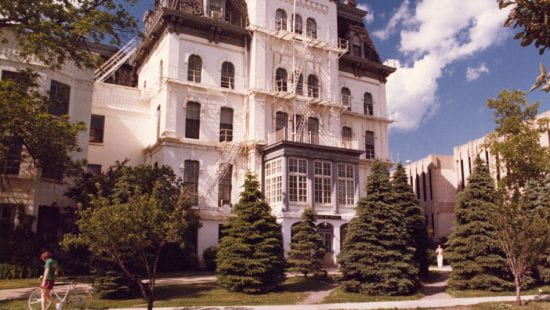Music Administration Building
In 1869 a group of prominent Evanston women founded the Evanston College for Ladies to provide female students with a respectable boarding house and with preparatory studies as they contemplated coursework at Northwestern University, which had recently adopted coeducation. The Evanston College for Ladies opened in fall of 1871 in a building at Chicago Avenue between Greenwood and Lake Streets, formerly occupied by the Northwestern Female College (no connection to the University). The 236 students in attendance included Sarah Rebecca Roland, later Northwestern University’s first female graduate.
When the trustees of the Evanston College for Ladies sought affiliation with Northwestern University, the University stipulated that the College for Ladies must provide its own facilities. By this time, the former Female College building was in poor condition, so the Evanston College trustees began raising funds to build a new structure on land obtained from the city of Evanston, north of Clark Street between Sherman and Orrington Avenues. A “Ladies’ Fourth of July” event in 1871 raised $30,000, and the cornerstone of the new edifice, designed by architect Gurdon Randall, was laid. However, after the Chicago Fire in October, 1871, many prospective donors were unable to honor their pledges. Construction languished until 1873, when Northwestern finally ratified the absorption of Evanston College for Ladies into the University and pledged $50,000 to complete the building. At this point, the name Evanston College for Ladies was dropped and the school was christened the Woman’s College of Northwestern University—known colloquially as “Fem Sem.” It was under these auspices that the building opened in 1874.
The original plan for the building had included an imposing, spire-like tower at one end of the building, but this was eliminated due to the subsequent shortage of funds. The Woman’s College was brick with stone trimming, in a French Second Empire style. With a ground-level basement and four proper floors under a mansard roof, the building was intended to provide housing for 135 students as well as classrooms. The first floor held reception parlors, dormitory rooms, the office of the Dean of Women, and a chapel; there were rooms for both students and faculty on the second and third floors; and music rooms and an art gallery occupied the top floor.
In 1901 the building was renamed Willard Hall, in honor of Francis E. Willard, the Evanston woman known nationally for her leadership roles in the temperance and woman suffrage movements. Willard, an alumna of the Northwestern Female College, had been named president of the Evanston College for Ladies at its inception, and served as dean of the Woman’s College for a year after it merged with Northwestern University.
During the following decades, Willard Hall served as Northwestern’s main woman’s dormitory and as the center of women students’ social and religious life. From 1927 through 1938, it housed freshmen women exclusively. In 1938 a newly constructed woman’s dormitory at the western end of the south quads was given the name Willard Hall. The west wing of the original Willard was converted to classrooms and offices, while the main part of the building became a student union, housing the headquarters of fifty student organizations, a music lounge, and a library. The departments of mathematics, art, and psychology were also located in the building.
In 1940 the School of Music, strapped for space in its quarters at the Music Building at 1822 Sherman Avenue, moved to its new home in the original Willard Hall, which was renamed the Music Administration Building. The student union was relocated to the recently completed Scott Hall.
The Music Administration Building underwent an extensive renovation in 1988. The mansard roof was re-shingled, sprinkler and fire doors were installed, and both the interior and exterior walls were repainted. The renovation earned a preservation award from the Evanston Preservation Commission and the Preservation League of Evanston.







